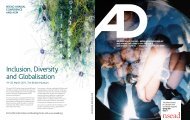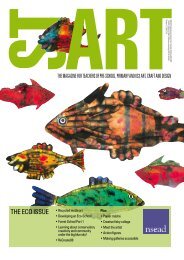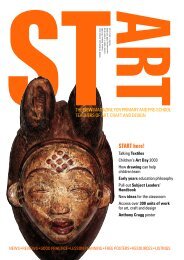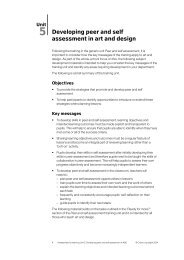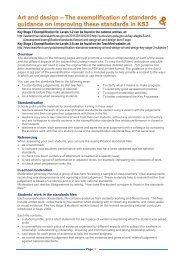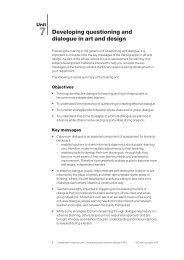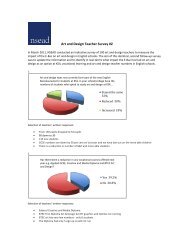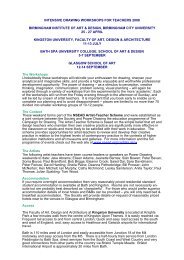Research in Visual Arts Education - Bilderlernen.at
Research in Visual Arts Education - Bilderlernen.at
Research in Visual Arts Education - Bilderlernen.at
You also want an ePaper? Increase the reach of your titles
YUMPU automatically turns print PDFs into web optimized ePapers that Google loves.
FROM PSYCHOLOGY TO SEMIOTICSyears: nudes, oil pa<strong>in</strong>t). He ad voc<strong>at</strong>ed a broader orient<strong>at</strong>ion towards newsubjects, such as picture analy sis, film and TV, present-day cultural studiesand so on. Like most students of art educ<strong>at</strong>ion and many art teachers, hewanted to broaden the subject of Draw<strong>in</strong>g <strong>in</strong> schools to <strong>in</strong>clude the study ofall forms of visual communic<strong>at</strong>ion. However, both the board of the N<strong>at</strong>ionalCollege of <strong>Arts</strong>, Crafts and Design and the N<strong>at</strong>ional Board of <strong>Educ<strong>at</strong>ion</strong>were opposed to these ideas. Only through a unique <strong>in</strong>tervention by theM<strong>in</strong>ister of <strong>Educ<strong>at</strong>ion</strong> <strong>at</strong> the time, Olof Palme, was Nordström elected bythe government as the director of the art educ<strong>at</strong>ion department.The 1969 and 1980 school curriculaAs a consequence of further actions by a new gener<strong>at</strong>ion of art teacher tra<strong>in</strong>ers,the 1969 Compulsory School Curriculum (Lgr 69) was revised, al thoughthe revisions primarily concerned Draw<strong>in</strong>g <strong>in</strong> the secondary school. In the1980 Compulsory School Curriculum (Lgr 80), not only the name of thesubject was changed to Pictorial Studies (Sw. Bild), but the subject was completely redef<strong>in</strong>ed on all levels of school<strong>in</strong>g along the l<strong>in</strong>es drawn up <strong>in</strong> thel<strong>at</strong>e 1960s. Vi sual communic<strong>at</strong>ion is emphasized already <strong>in</strong> the first sentencesof the discription of aims:Students shall develop their ability to cre<strong>at</strong>e images <strong>in</strong>dependently, to com muni c<strong>at</strong>e withimages and to critically analyse images of different k<strong>in</strong>ds. They shall under stand pictorialre present<strong>at</strong>ion as a langu age and be able to use visual language as an important means ofcommunic<strong>at</strong>ion along with speak<strong>in</strong>g, read<strong>in</strong>g and writ<strong>in</strong>g (Lgr 80, p. 69).The subject is divided <strong>in</strong>to five oblig<strong>at</strong>ory parts: <strong>Visual</strong> Production, Pic tureAnaly sis, <strong>Visual</strong> Com mu nic<strong>at</strong>ion, Aesthetic Orient<strong>at</strong>ion, and Image &Environment. <strong>Visual</strong> Produc tion should “provide space” for the students’own imagery and make them familiar with the pro duc tion of photos, filmand video. The ma<strong>in</strong> purpose of Pic ture Analysis is to crit i cal ly exa m<strong>in</strong>ethose pictures students meet <strong>in</strong> their everyday life. <strong>Visual</strong> Communic<strong>at</strong>ionshould teach students how to use pictures for different purposes, such asto convey <strong>in</strong> form<strong>at</strong>ion and news, persuade and advertise, enterta<strong>in</strong> andridicule. Aesthetic Orien ta tion is the only part of the curriculum where “art”is mentioned and then only as one of a variety of altern<strong>at</strong>ives to se cond-r<strong>at</strong>ecommercial pictur es. In Image & Environment conceptual analysis of the<strong>in</strong>flu ence of mass media is given prime importance over the visual explor<strong>at</strong>ionof the local environ ment.NORDIC VISUAL ARTS EDUCATION IN TRANSITION 43




